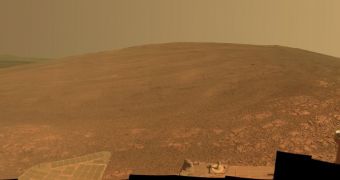Regions of scientific interest for both NASA rovers still active on the Red Planet have been named in honor of renowned planetary scientist Bruce Murray (1931-2013). These features will be investigated in detail as the two robots move ever forward in their quest to understand Mars.
The NASA Mars Exploration Rover (MER) Opportunity will be investigating a structure called Murray Ridge, which is the edge of an uplifted crater rim. On the other side of the planet, the Mars Science Laboratory (MSL) rover Curiosity is studying a feature called Murray Buttes.
Murray was a planetary geologist with the California Institute of Technology (Caltech), and a member of numerous science teams in charge of setting the stage for NASA space and interplanetary exploration missions. His groups were involved in planning several robotic missions to Mars as well.
The expert worked on laying a solid groundwork for robotic space exploration throughout the 1960s and 1970s, and then went on to direct the NASA Jet Propulsion Laboratory (JPL) at Caltech between 1976 and 1982. In 1980, he was one of the co-founders of the Planetary Society.
“Bruce Murray contributed both scientific insight and leadership that laid the groundwork for interplanetary missions such as robotic missions to Mars, including the Mars rovers, part of America's inspirational accomplishments,” says the manager of the NASA Mars Exploration program at JPL, Fuk Li.
“It is fitting that the rover teams have chosen his name for significant landmarks on their expeditions,” the scientist adds. Bruce Murray passed away on August 29, 2013, at the age of 82.
His name will live on in the western rim of the Endeavour Crater, now called Murray Ridge. Opportunity has been investigating this location for the past two years, though its mission on Mars spans nearly a decade. The rover landed on the Red Planet in 2004, and somehow survived ever since.
Murray “led JPL during a time when the planetary exploration budget was under pressure and the future for planetary missions was not clear. His leadership brought us through that period with a strong exploration program,” explains MER principal investigator Steve Squyres, from Cornell University.
On the other side of Mars, Curiosity will soon start investigating a series of small, steep-sided knobs, which are located at the base of Mount Sharp, the 5-kilometer (3-mile) high central feature of Gale Crater. Scientists say that these features look like a miniature version of Utah's Monument Valley.
“Bruce Murray was a sedimentologist, so the sedimentary rocks we expect to see at Murray Buttes would have been especially interesting for him. He would have loved this,” says USGS Astrogeology Center expert Ken Herkenhoff, who was one of Murray's graduate students in the 1980s.

 14 DAY TRIAL //
14 DAY TRIAL //